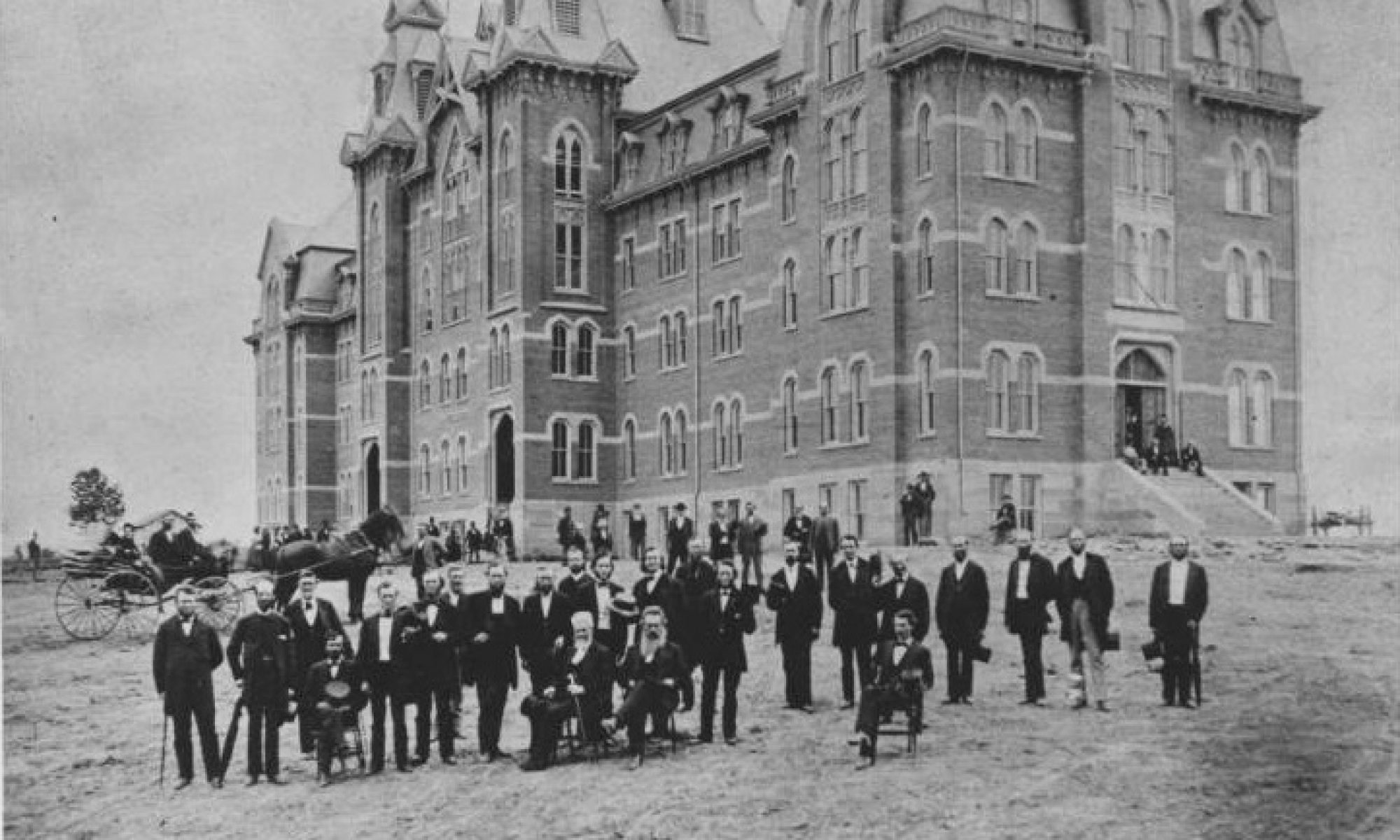Introduction | The Founding | The Founders | The Universalists | The Building | The President and the Faculty | The Students and the Curriculum | The Flourishing
Classes at Buchtel College opened on September 11, 1872. Forty-six collegiate and 171 preparatory students arrived for the beginning of classes. According to the late Dr. George W. Knepper, University Historian Emeritus, they were quite an assortment of ages and backgrounds. Some of the early students were from prominent Akron families; however, the majority came from rural areas, small towns and farms. This is not surprising as the Universalists were the largest contingent of students. There were great variations in age and maturity in the early student groups, from a 10-year-old first-year prep student to mature adults.
The early students received special attention from President Sullivan H. McCollester, who often visited sick students at night, and John and Elizabeth Buchtel, who provided needy students with food, loans and housing. This made many students feel at home, and they were quite appreciative. Not all students were completely satisfied, however, and a few students voiced their complaints. Some of the dissatisfaction during the early years included the quality of the food and the high cost of tuition and room and board. As a cheaper alternative to dormitory living, boarding clubs were formed and most males lived in off-campus residences.
Most of Buchtel College’s early students were enrolled in the four-year Classical Course, which led to the Bachelor of Arts degree and was the heart of the collegiate program. A strong three-year secondary school preparation was required to meet the admission standards for this program, which were essentially the same as Yale University, against which Buchtel College measured itself. Only the most advanced students pursued the Classical Course of study. For the less well-prepared students, a two-year Philosophical Course was offered, terminating in the Bachelor of Philosophy degree. A Scientific Course was later added in 1873 and led to the Bachelor of Science degree. The curriculum essentially remained unchanged throughout the Buchtel College years (1870-1913) and would not see major changes until the dawn of The Municipal University of Akron.
Student life during the early years of Buchtel College was dominated by restrictive rules and regulations. The founders of the college, the Universalists, regarded smoking, drinking, swearing, gambling and failure to attend Sunday services as sinful and a cause for concern if not alarm. There were also regulations designed to keep men and women as separate from each other as possible. Nonetheless, Buchtel College students quickly found a variety of ways, including pranks and horseplay, to not only enliven their spirits, but also to demonstrate their discontent and rebel against this strict religious lifestyle.
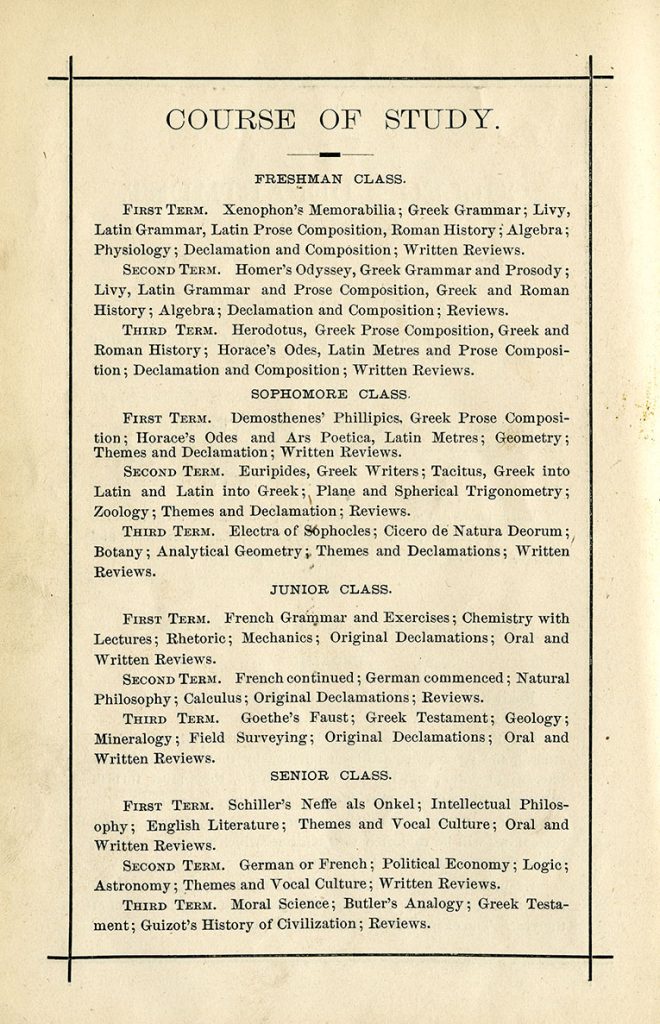
From The University of Akron Publications Collection in Archival Services.
This page from the first Buchtel College Catalogue gives a glimpse into the early curriculum at the school. It outlines the Course of Study for what was known as the Classical Course, which focused heavily in foreign languages, ancient history and literature, math, and the sciences. It was a four-year degree that led to a Bachelor of Arts. Other options were the two-year Philosophical Course, which led to the Bachelor of Philosophy degree. A Scientific Course, started in 1873, permitted more time spent on the natural and physical sciences and resulted in the Bachelor of Science degree upon graduation.
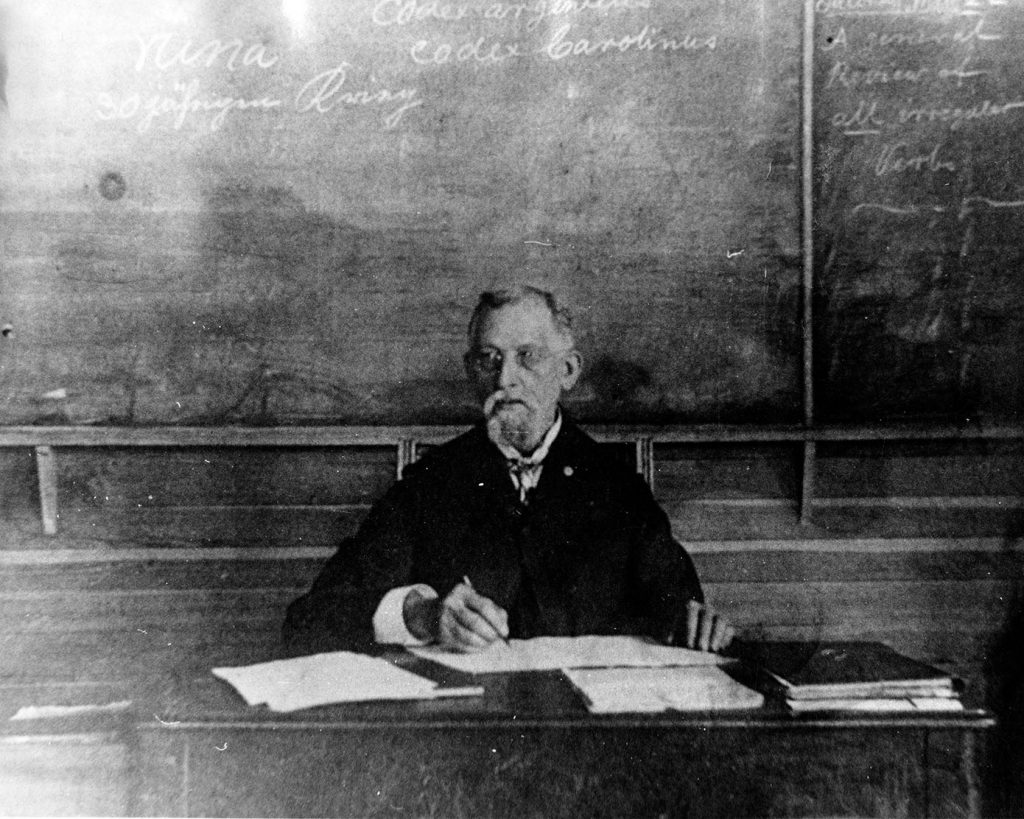
From the University of Akron Photograph Collection in Archival Services.
This image shows Dr. Carl F. Kolbe, Professor of Modern Languages at Buchtel College, sitting at his desk in his classroom in East Hall in Old Buchtel Hall during the first recitation at the college on the day classes opened on Wednesday, September 11, 1872. The image has the following text on the back: “Students and faculty picked their way among carpenter’s benches and shavings of the still unfinished Buchtel Hall to attend the first recitation conducted at Buchtel College by Professor Carl F. Kolbe, whose son, Dr. Park R. Kolbe was to be the institution’s 7th president.” While looking at this photograph, one wonders how many colleges have an image depicting the first class on the opening day of the institution.

Photograph from The University of Akron Photograph Collection in Archival Services.
Chemistry classes were part of the curriculum at Buchtel College from the start of the institution. The classes were taught by Dr. Charles M. Knight, starting in 1875. Under his direction, the chemistry program grew and flourished. The class seen in this photograph is conducting experiments in the basement of Old Buchtel Hall where Knight, with student help and a little ingenuity, created his own chemistry classroom and laboratory. This ingenuity, coupled with his extensive knowledge of rubber chemistry, led him to teach the world’s first rubber chemistry course, in 1909. This eventually led to the creation of the Institute for Rubber Research in 1956 and the College of Polymer Science
and Polymer Engineering in 1988, which is recognized as one of the world’s best.
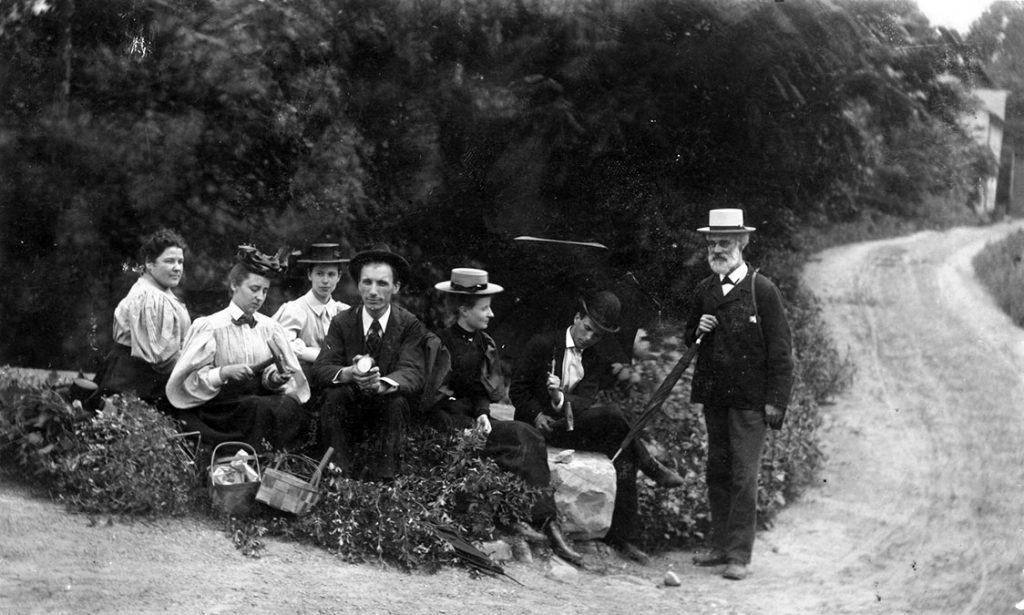
Photograph from The University of Akron Photograph Collection in Archival Services.
During the Buchtel College years (1870-1913), students studied around a core four-year Classical Course, which resulted in a Bachelor of Arts degree. The curriculum focused on modern languages and the natural and physical sciences. Classes in the natural sciences often necessitated field trips to examine the natural world that could be readily accessed around the campus at that time. While the city has built up around the University over the years, students still have many opportunities today to take advantage of the great outdoors, including local parks like the Cuyahoga Valley National Park and Summit Metro Parks, and many hike and bike trails such as the Towpath Trail that are a stone’s throw away from college campus..
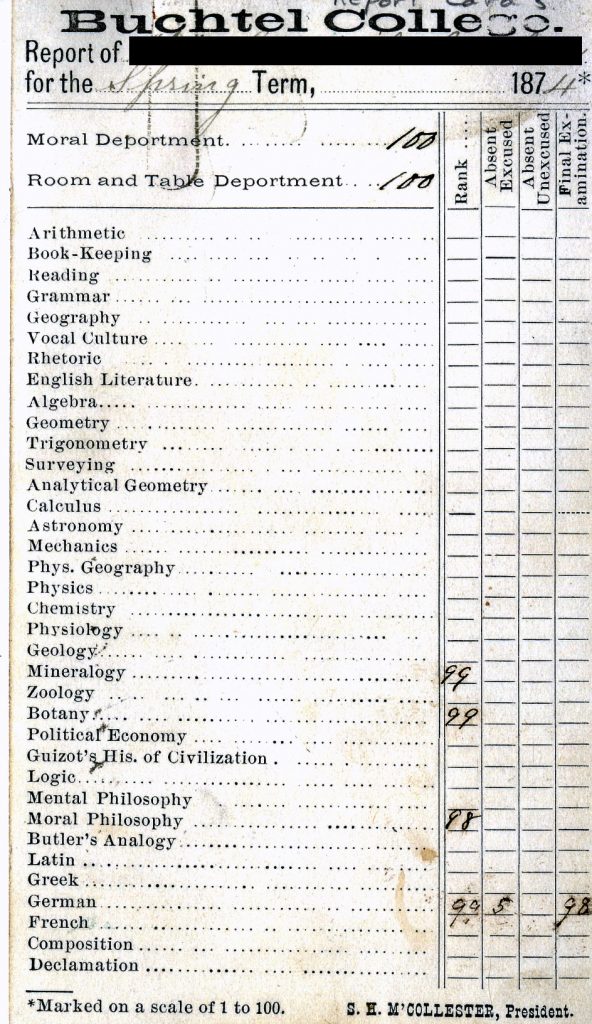
From the Buchtel College Records in Archival Services.
This report card is one of the earliest surviving student records in the University Archives. Due to federal law, the name of the student has been redacted to protect their identity, but the classes listed on the report card speaks volumes about the early curriculum and difficult coursework that made up the student schedule in the early days of the college, which is very different from today.
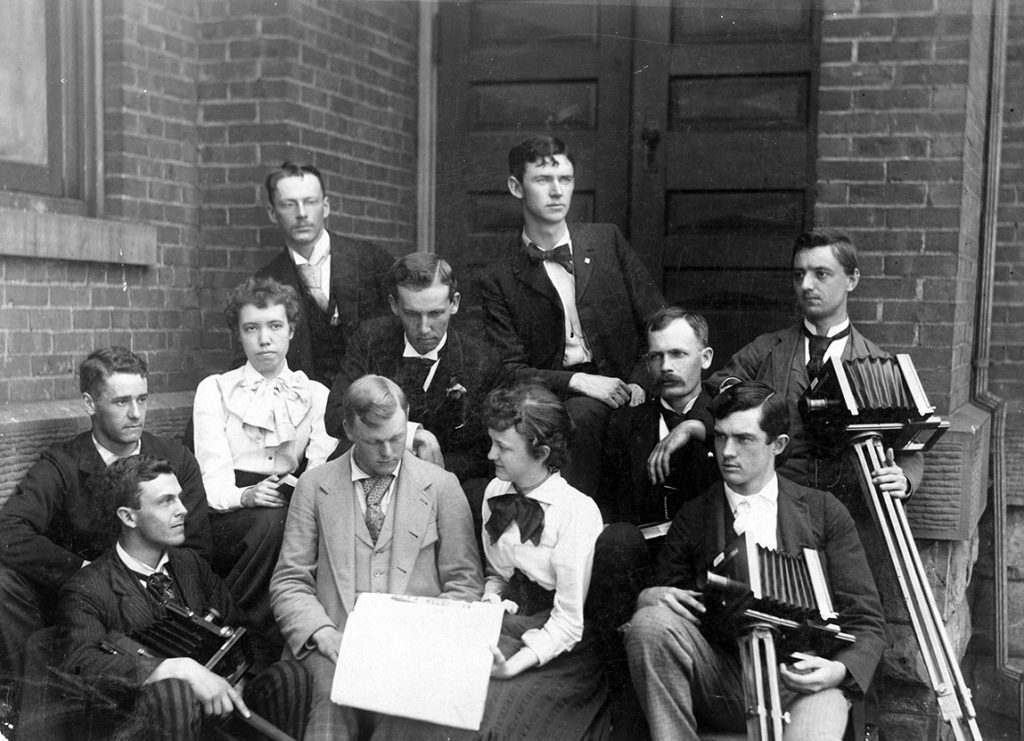
Photograph from The University of Akron Photograph Collection in Archival Services.
In addition to more “serious” classes in modern languages and the natural and physical sciences, Buchtel College eventually offered courses in the fine and performing arts. The Department of Painting and Drawing (renamed the Department of Art in 1886) opened in 1883. During the early years, the department only offered classes in drawing, which were required for the curriculum. Other classes, including painting and photography (as seen here), were added in the late 1880s and early 1890s, but must have been elective courses, as they were not a requirement of the Classical, Philosophical, or Scientific courses of study. Most courses in the Department of Art and the Department of Music were dropped under the administration of President Orello Cone in the early 1900s with an idea of concentrating more upon the strictly “legitimate” fields of secondary and collegiate training, but would later return to campus and would grow and flourish into the rich and diverse curriculum that it is today.

From The University of Akron Publications Collection in Archival Services.
This page from the first Buchtel College Catalogue shows expenses for the inaugural school year, from 1872-73. Student expenses included $30.00 per year for tuition and $10.00 for room rent. While this seems inexpensive, comparative costs for the 1870s shows that wages averaged only $8.00 per week, a new house cost between $400 to $800, and a loaf of bread cost five cents. However, board at the college, which included lights, washing, and heating, cost $5.00 per week. Most students found this exorbitant and often complained, and some chose to live off campus, much like today.

Photograph from The University of Akron Photograph Collection in Archival Services.
Many students found the $10.00 per year room rental fee and especially the $5.00 per week board fee extravagant. Therefore, many of them, mostly men, decided to live off campus to save money. One of the most popular and memorable student boarding houses was the one run by Lucinda W. “Aunty” Brown, which affectionately became known as the “Old Shoe.” Brown was the widow of a Universalist minister who came to Buchtel College at the urging of John Buchtel. She visited Akron in 1878 and spent the next 30 years working on behalf of Buchtel College students. She became like a surrogate mother to many of them and is remembered fondly by the students of that era.
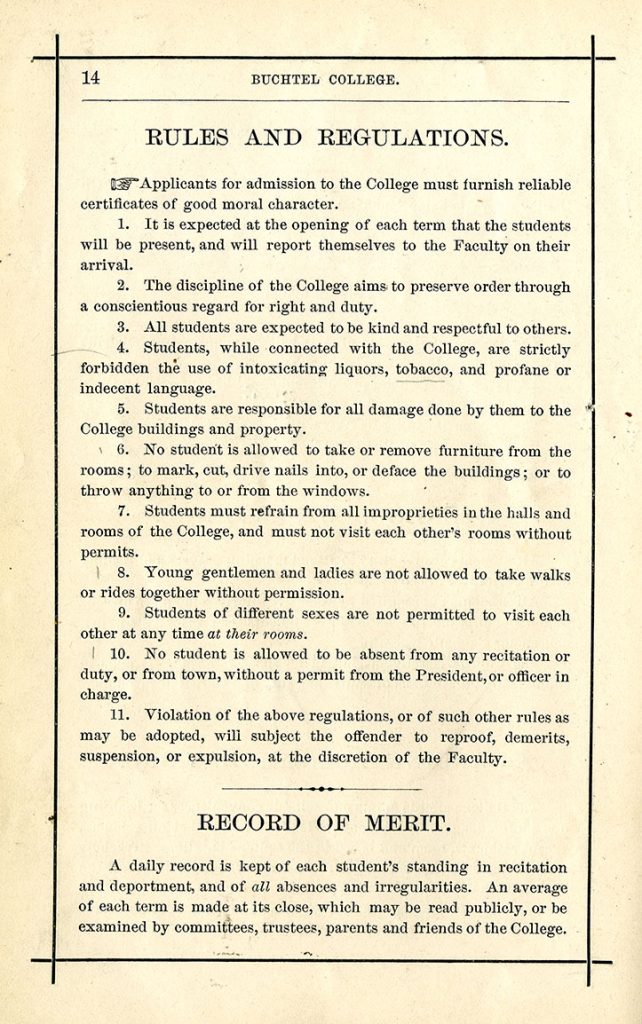
From The University of Akron Publications Collection in Archival Services.
Student life during the early years of the school was rather grim, governed by strict rules and regulations of the college founders. This page from the first Buchtel College Catalogue details the long list of “do’s and don’ts” early students were expected to follow. Some of the harshest judged by today’s standards include No. 8 “young gentleman and ladies are not allowed to take walks or rides together without permission;” No. 9, “Students of different sexes are not permitted to visit each other at anytime at their rooms;” and No. 4, “students…are strictly forbidden the use of intoxicating liquors, tobacco, and profane or indecent language.” While the atmosphere at the college became less strict in the last decades of the 19th century, faculty and administrators continued to keep a close watch on student morality and conduct.
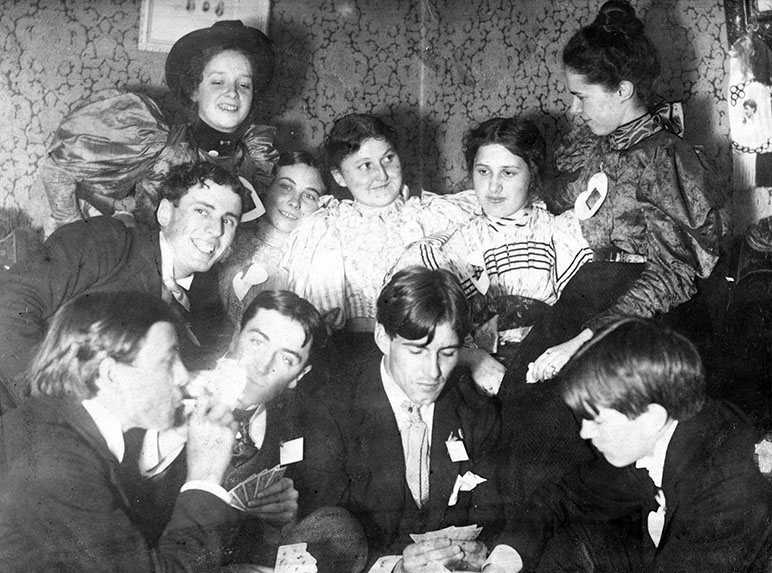
Photograph from The University of Akron Photograph Collection in Archival Services.
During the early years of Buchtel College students of the opposite sex were not permitted to socialize. In fact, the men’s dorm (East Hall) and the women’s dorm (West Hall) were on opposite ends of the Main College Building. In addition, drinking, smoking, gambling, and failure to attend Sunday services was cause for alarm. Therefore, students often had class socials like the one pictured here off campus or took picnics and walks in the local parks and pastures that surrounded the school, away from the watchful eyes of the faculty and administrators. This provided a brief respite from the confines of the college and the strict rules of the Universalists that dominated early student life.
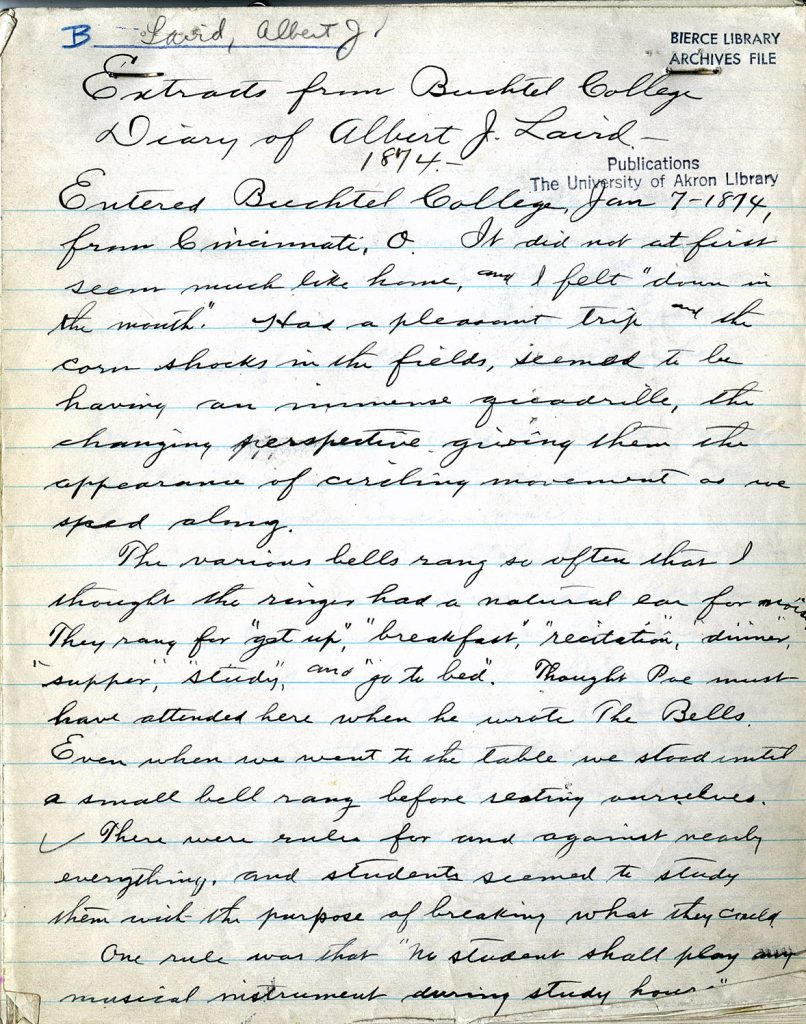
From the Buchtel College Records in Archival Services.
This page from the diary of early Buchtel College student Albert J. Laird of Cincinnati, Ohio speaks volumes about the early days at the college. Like most students of his day, Laird complains incessantly about almost everything under the sun, especially the ringing of the school bells. He writes with a sense of humor that “the various bells rang so often that…I thought [Edgar Allan] Poe must have attended here.” He also comments on the strict rules at the school, commenting that “there were rules for and against nearly everything, and students seemed to study them with the purpose of breaking what they could.” His sentiment is probably not much different from students at schools across the country down through the ages.
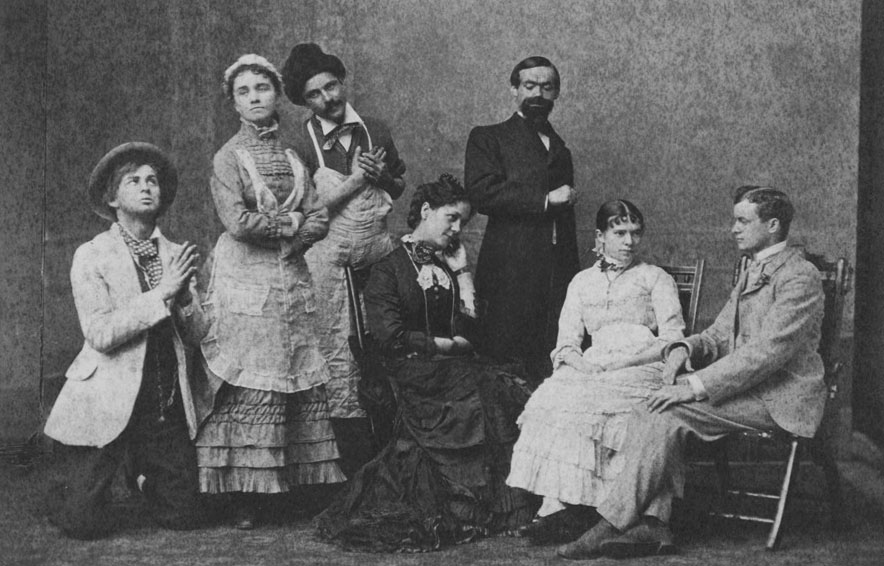
Photograph from The University of Akron Photograph Collection in Archival Services.
While the curriculum was very structured during the early days of Buchtel College and did not leave much time for extracurricular activities, students still found time for the arts, which were a part of the institution’s history almost from the start. Student organizations including the Cary Literary Society for women began in 1872, and the William Cullen Bryant Society for men started shortly thereafter, followed by a drama study club. Performances by these groups often occurred after chapel services. This image shows Buchtel College students performing a drama called “The Last Loaf” in 1873, a year after the college opened. The play, a 19th century drama about Temperance by American playwright George M. Baker, was performed to a standing room audience in the Buchtel College Chapel and received rave reviews. Buchtel College’s first graduate, Susie Chamberlain, is pictured in the center of the photograph.

